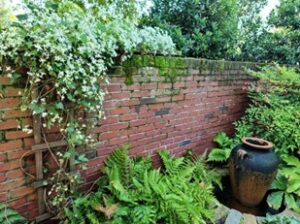By: Avery Meyers
Driving through neighborhoods in DC and Northern Virginia, you will notice beautifully trained ivies and roses along walls and lattices, wisteria covering arbors, and vinca covering garden beds. Vines fill many important needs in landscaping and can be stunning when placed thoughtfully and well maintained. However, these incredible plants can have a detrimental effect on a property when used improperly or ignored.

There are many diverse types of vines found throughout the world, which is why it is important to know the difference between them. “Vine” is an overly broad term for a plant that is unable to support itself, so it creeps across the ground or grabs onto anything nearby to help. There are a few ways they do this, and this will be a key factor in deciding where to plant which vine and how to support it.

Sweet peas, passionflower, and clematis are good examples of “tendril-climber” vines. These send out thin, flexible stems from their nodes that wrap around supports. Since the tendrils need something small enough to wrap around, they are best grown on lattice or arbors with horizontal or vertical wires depending on the intended growth. Be careful not to let these tendrils wrap around nearby plants as they can be impossible to untangle without cutting them out.

Other vines, like our native wisteria and honeysuckle, simply wrap their true stem all the way around a support to climb. These “twining” vines also grow well on lattice or arbors, usually without needing the wire, but should be tied up in the early growing stage. They can also easily climb poles or trail across railings. Placing these to grow along drainage or electrical structures should be avoided as the stems can get heavy and strong enough to dislodge them.

Another way vines attach themselves is by aerial, or adventitious roots that protrude from the sides of the stem, or sometimes even from the leaves, and tightly fasten themselves flat against a support. Some of the most common vines we see in the garden, English ivy and climbing hydrangeas, are “clinging” vines. This type of vine, while it does serve purpose, can cause big problems. The roots will embed themselves on rough surfaces like brick, wood, or stucco and they try to get deep into any cracks they can find. Removing clinging vines from walls is exceedingly difficult and always leaves behind marks from where the roots had been attached. These can grow very well on decorative or barrier walls around the garden but should not be grown directly on the walls of the house to avoid lasting damage.

Some vines do not even have a way of attaching themselves naturally to a support, and instead either sprawl up and out, to create more of a shrub shape, or trail across the ground in every direction it is allowed to wander. “Sprawling” vines, like climbing roses, can be trained to cover a wall by mounting eye hooks in the wall and tying them up with twine or garden wire. Roses can sometimes just be hooked to lattice using the prickles on the stem. These are usually the least harmful to train up a wall of a house because they have no way of embedding themselves into openings. “Trailing” vines like Vinca or Creeping Jenny can be used to cascade out of a pot or fill garden beds with a lush carpet of foliage instead of showing mulch. It should be noted that extra maintenance will be needed to keep trailing vines off the bases of shrubs and trees to provide sufficient air flow and light to the trunks.
There are over a dozen more ways vines grow and climb but these are the most seen in this area. When choosing a vine, always consider the future of the plant. Whether it is training the vine up a lattice, pruning it away from other plants or windows, or even removing dead leaves and cluttered branches that can trap moisture against a wall, vines will always need regular maintenance to keep them from turning into the scene in Jumanji, large masses you see entangling entire forests on the side of the highway. Proper plant selection and maintenance goes a long way to keep a property beautiful and healthy, especially when it comes to vines.




